This post talks on How To Decorate A Small Space Without Making It Feel Cluttered
I’ve lived in small apartments almost my whole adult life. From a one-room studio with barely enough space to stretch my arms to a little two-bedroom that if am being honest, it felt more like a shoebox than a home.
And the thing about small spaces is that It doesn’t take much for them to feel like a storage closet. One extra chair, one badly placed shelf, and suddenly it’s chaos.
You lose flow, you lose function, and worst of all you lose that calm, comforting feeling a home is supposed to give.
I used to rearrange my room almost every other week, just trying to make it work. At some point, I realized I wasn’t decorating, I was just trying to breathe.
I was trying to figure out how to walk from my bed to the door without knocking something over or bruising my leg on the corner of a coffee table I didn’t even want in the first place.
And I know I’m not the only one. Definitely not.
The struggle is real when you’re working with limited space. You want your room to feel calm, inviting, even a little stylish.
Not cramped, chaotic, and covered in things you didn’t really plan to keep but had nowhere else to put.
Maybe you’ve got a tiny bedroom, a little corner in a shared apartment, or a home that just doesn’t come with built-in storage made for actual humans.
You want it to look good. Feel open. And not scream “I had no idea where else to put this” every time someone walks in.
And also, you’re not trying to spend a fortune. Or dispose half your stuff just to create a little breathing room. That’s fair.
This post is for you. We are sharing real, practical ways to decorate a small space without making it feel cluttered.
Ready? Let’s get into it.
How To Decorate A Small Space Without Making It Feel Cluttered
1. How Do You Make a Small Room Feel Less Cluttered?
Small rooms have a way of making little messes feel ten times bigger. Leave out a pair of shoes or drop your bag by the door, and suddenly it feels like the whole place is cluttered.
And that random chair in the corner is not helping.
Well, you don’t need to tear everything apart to fix it. Just a few smart changes can make your space feel fresh, open, and way more manageable.
Here’s how to go about it:
-
Start With a Decluttering Sprint

Before anything else, take a quick look around and ask yourself, “Do I really need all this in here? That’s the first step.
And, you don’t have to throw away everything you own. Just be honest about what actually gets used and what’s just sitting there taking up space.
Start small. Give yourself 20–30 minutes and tackle one section of the room, it could be that cluttered side table or that overflowing chair that became a clothes rack.
Remove anything that doesn’t need to be in the room. If you’re not using it daily or at least weekly, find a new home for it (another room, a donation bag, or storage).
Once you’ve cleared out the non-essentials, it’s time to think vertically. When you don’t have much floor space, the walls become your best friends.
Use shelves, hanging organizers, and tall cabinets to keep things off the ground but still accessible. It opens up the room and instantly makes it feel more breathable.
Use baskets and bins, preferably the type with lids. They help hide the mess while still keeping your stuff within reach.
And if you can, lean into multi-use furniture. Think ottomans with hidden compartments or beds with drawers underneath. The less you can see lying around, the bigger and calmer your room will feel.
-
Stick to a Light and Cohesive Color Palette
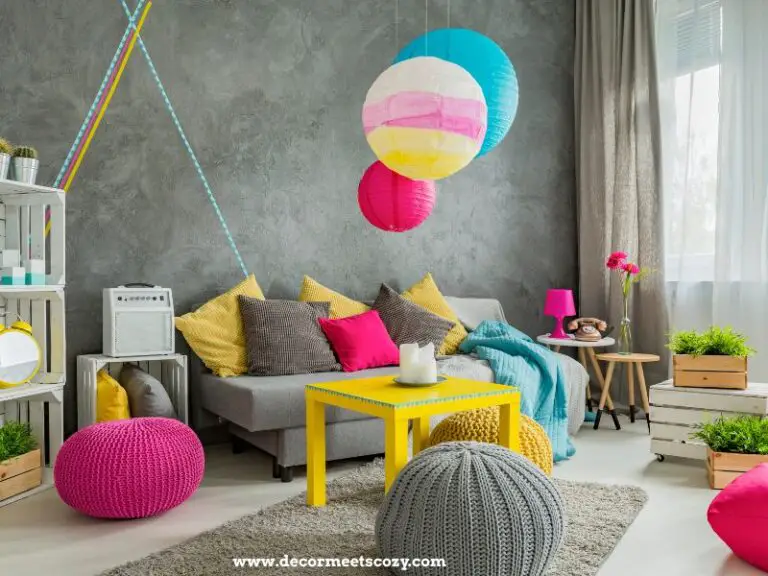
Colors play a huge role in how a space feels. Dark, heavy colors can make a small room feel even smaller, especially if there’s not a lot of natural light.
Light tones like soft white, beige, light grey, or even muted pastels help bounce light around the room, making it feel airier and more open.
But it’s not just about using light colors, it’s about keeping it well putted together
When there are too many different shades, patterns, or finishes, your eye doesn’t know where to look, and that creates visual clutter, even if the room is technically clean.
So, try sticking to one main color and two or three accent tones that work well together. Keep the walls, furniture, and even things like curtains and rugs within that same color family.
:If your furniture looks bulky or stands out too much, paint it to match your walls. It might sound strange, but when a bookshelf or dresser blends in with the wall, it visually “disappears.”
The room instantly feels less crowded, even though nothing actually changed in size.
2. How to Decorate a Very Tiny Room Without Overwhelming It
Decorating a small room can feel like a big challenge, but it’s totally doable. The key is to make the most of the space without making it feel crowded.
You want the room to feel cozy, but not cluttered. It’s about choosing the right pieces that fit well and keep the space open.
With a little creativity, you can turn even the tiniest room into a welcoming and stylish space without going overboard.
-
Use Scaled‑Down Furniture with Big Impact
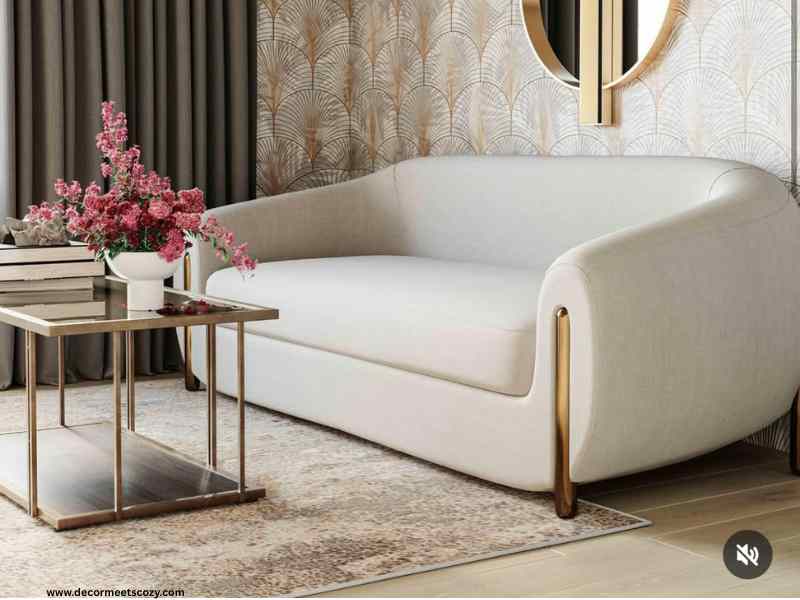
Photo Credit: @ inspire_me_home_decor
When you learn how to decorate a small space without making it feel cluttered, picking the right furniture is everything.
Instead of that oversized sofa that swallows half your room, look for a petite loveseat or a slimline settee. These smaller pieces give you seating without stealing all the floor space.
Here’s how to go about it;
- Measure first. Know exactly how much room you have before you shop. A tiny two‑seat sofa can fit where a full couch won’t, and you’ll still have space to move.
- Choose legs. Furniture with exposed legs looks lighter than solid‑skirted designs. You can even see the floor underneath, which tricks your eye into thinking there’s more space.
- Think multi‑use. An accent chair with storage under the seat or a bench that doubles as a coffee table can save you from adding extra bits of furniture.
By using pieces that match the scale of your room, you get big impact without big bulk.
-
Mirrors and Natural Light Are Your Best Friends
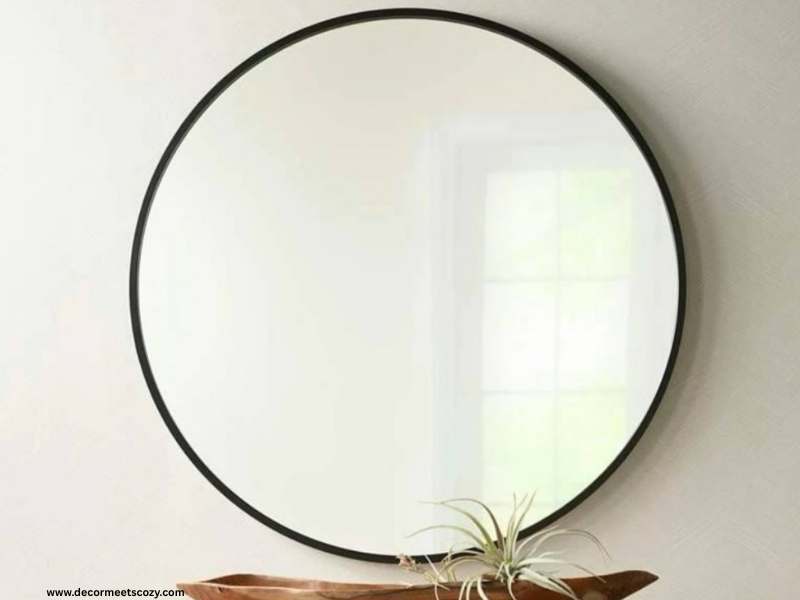
Photo Credit: @ affordableart.ng
Mirrors are like magic when you’re figuring out how to decorate a small space without making it feel cluttered, because they add depth and bounce light around.
- Place mirrors opposite or next to windows. When natural light hits the glass, it reflects back into the room, instantly making it feel brighter and larger.
- Go for a thin frame or no frame at all. The less visual weight on the wall, the better. A frameless or slim‑lined mirror won’t fight for attention.
- Use mirrored furniture sparingly. A small mirrored side table or tray can double your light without overwhelming the space.
Let the sun do part of the work, combine it with well‑placed mirrors, and your room will feel open and airy, even if it’s tiny.
3. How Do You Maximize Space in a Tiny Room?
When you’re learning how to decorate a small space without making it feel cluttered, every inch counts.
Making use of your walls and choosing furniture that pulls double duty can turn a tight squeeze into a comfy, organized spot.
-
Go Vertical with Shelves and Wall‑Mounted Pieces
Using vertical space should be considered when decorating a small room. Instead of filling up the floor, think about going up. Shelves and wall-mounted pieces can free up valuable floor space while giving you room for storage or decorative touches.
Look up instead of out. Using your walls can free up floor space and make the room feel taller
- Tall bookshelves: A shelf that reaches near the ceiling draws your eye up and gives you serious storage without eating floor space.
- Floating shelves: Mount thin boards above desks, beds, or even door frames. They hold books, plants, or everyday items and keep surfaces clear.
- Wall hooks and pegs: Perfect for coats, bags, scarves or even a row of mugs in a kitchenette. Keeps things off the ground and easy to grab.
- Vertical planters: If you love greenery, hang small pots in a column or use a slim wall rack. You get life and color without blocking walkways.
-
Multi‑Functional Furniture Is a Game‑Changer
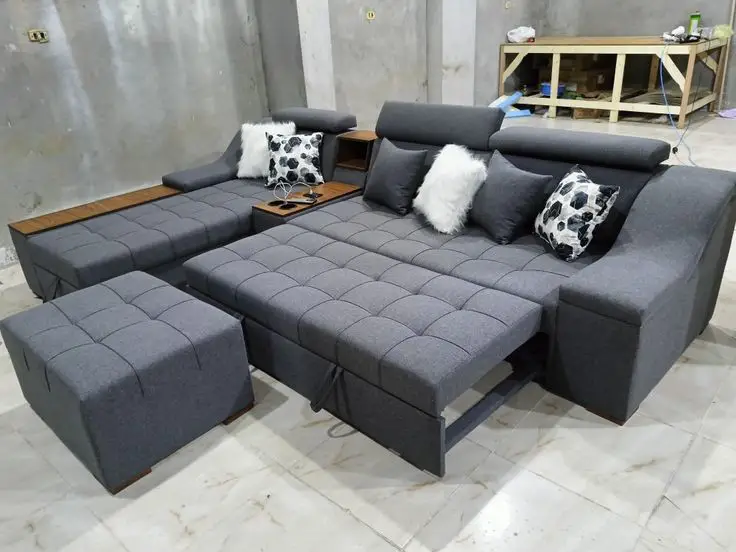
Multi-functional furniture is incredibly useful, especially when space is limited. Pieces that do double duty not only save space but also keep your space organized and stylish.
When space is tight, choose pieces that do more than one job. This is a core trick for how to decorate a small space without making it feel cluttered:
- Ottomans with storage: A cushioned ottoman can hide blankets, shoes, or games inside and serve as extra seating or a footrest.
- Sofa beds or daybeds: Use it as a couch during the day, then turn it into a bed at night. You save room and skip buying a separate sofa and bed.
- Fold‑out desks or drop‑leaf tables: Fold them out when you need a workspace or dining table. Fold them back up to reclaim precious floor area.
- Nesting tables: Keep a set of small tables tucked under a larger one. Pull them out only when guests arrive or when you need extra surface space.
Maximizing vertical space and choosing multi‑use furniture are simple, budget‑friendly ways to make a tiny room feel open. You’ll get the storage and function you need without the clutter.
4. Low Budget Small House Interior Design Ideas
When working with a small space and a tight budget, the challenge is to maximize both functionality and style without breaking the bank.
Smart design choices can make a significant difference, ensuring that your home feels spacious, comfortable, and aesthetically pleasing, all while keeping costs down.
Here are a few thoughtful, cost-effective approaches to interior design for small homes:
Thrift Stores, DIYs, and Upcycled Decor
One of the smartest ways to learn how to decorate a small space without making it feel cluttered is to shop second‑hand.
Thrift stores, flea markets, and online marketplaces are full of hidden gems you can get in an affordable price.
Think a wooden side table that just needs a fresh coat of paint, or a metal chair whose legs you can sand and spray‑paint to match your room.
- Pick strong, simple pieces. Choose furniture with a solid frame and clean lines. If the fabric is worn, just cover it with a new slipcover or reupholster later.
- Give old furniture new life with paint.All you need is sandpaper, chalk paint, and a new knob. Sand the surface lightly, paint two coats, and swap the knob. Suddenly, that old dresser looks fresh and fits your style.
- Turn trash into treasure.Take an old wooden ladder and hang it on the wall for towels. Or stack wooden crates and attach them to the wall as shelves.These easy projects cost almost nothing and keep your small space neat and interesting.
By picking up pieces on a budget and putting in a little elbow grease, you get unique furniture and learn how to decorate a small space without making it feel cluttered, because you’ve tailored every piece to your exact needs.
-
Budget‑Friendly Decor Swaps That Make a Difference
You don’t have to redo the whole room to get a big change. Small swaps to the walls, floor, or lights can make your space feel new without costing much.
- Peel‑and‑stick wallpaper comes in endless patterns and peels off cleanly when you want a new look. Apply it to one wall as an accent or even the back of a bookcase for a pop of color.
- Adhesive tiles are a game‑changer in kitchens or bathrooms. They stick over old surfaces and mimic expensive ceramic or subway tile at a fraction of the cost.
- LED strip lights under cabinets or along ceiling coves add warm or cool glow without rewiring. They’re cheap, easy to install, and instantly make your space feel cozier.
- Dollar‑store curtain rods and simple curtains can frame windows and hide storage. A light, semi‑sheer curtain hung just above the window makes the ceiling look taller and lets in more daylight.
These small swaps teach you how to decorate a small space without making it feel cluttered by focusing on low‑cost, high‑impact changes. You end up with a room that feels fresh and yours without the hefty price tag.
5. Simple Interior House Design for Small Spaces
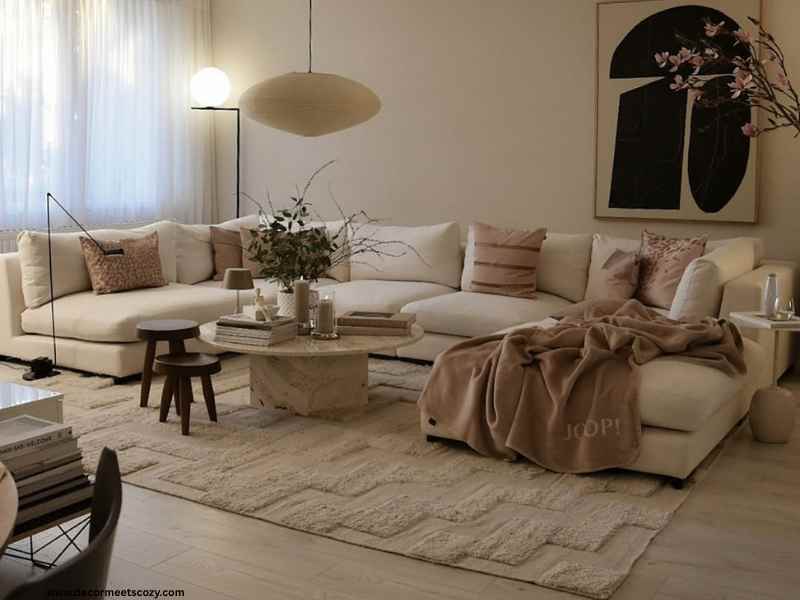
Photo Credit: @ zeynepshome
Designing a small home doesn’t have to feel overwhelming. The key is to focus on a few clear rules that keep your space open and calm. Here are some smart ideas to help you learn how to decorate a small space without making it feel cluttered:
-
Create Zones in One Room Using Rugs or Lighting
When you learn how to decorate a small space without making it feel cluttered, dividing the room into clear zones can help you use every inch well.
- Use rugs to mark areas. Lay a small rug under your bed or couch to show that’s the sleep or lounge spot. Place a different rug under your desk to signal a work zone. Even if the rugs are simple and close in color, they tell your brain, “This is where I read,” or “This is where I work.”
- Add focused lighting. A floor lamp next to a chair makes a cozy reading nook. A desk lamp over your workspace says, “Time to get things done.” You can also hang a small pendant light above a table or use string lights around a corner to show it’s a chill spot.
- Keep pathways clear. Make sure your zones don’t overlap too much. Leave a clear path between the bed, desk, and door. That way, when you’re moving around, you won’t feel like you’re stepping on different spaces.
By using rugs and lights, you create clear areas that feel separate but still flow together, without making your room look busy.
-
Keep Decor Minimal, But Meaningful
The trick to how to decorate a small space without making it feel cluttered is to pick a few items that matter, rather than filling every shelf.
- Choose things that tell your story. A favorite family photo in a small frame, a travel souvenir from a special trip, or a piece of local art can bring warmth without taking up much room.
- Limit the number. Aim for five to seven special pieces total. Put them where you’ll see them, but leave plenty of open space around.
- Rotate seasonally. Every few months, swap out one or two items. This keeps your space fresh and gives you a chance to enjoy each piece.
When you pick decor with care, your room feels personal and calm. You’ll have just enough to make it yours, but not so much that it feels crowded.
When you learn how to decorate a small space without making it feel cluttered, you start to see each item as part of a clever solution, not just more stuff.
So don’t let a small room hold you back. Treat it like a playground for your style, a chance to get creative on a budget and discover what truly feels like home.
Your space might be small, but your style doesn’t have to be.
Leave a Reply